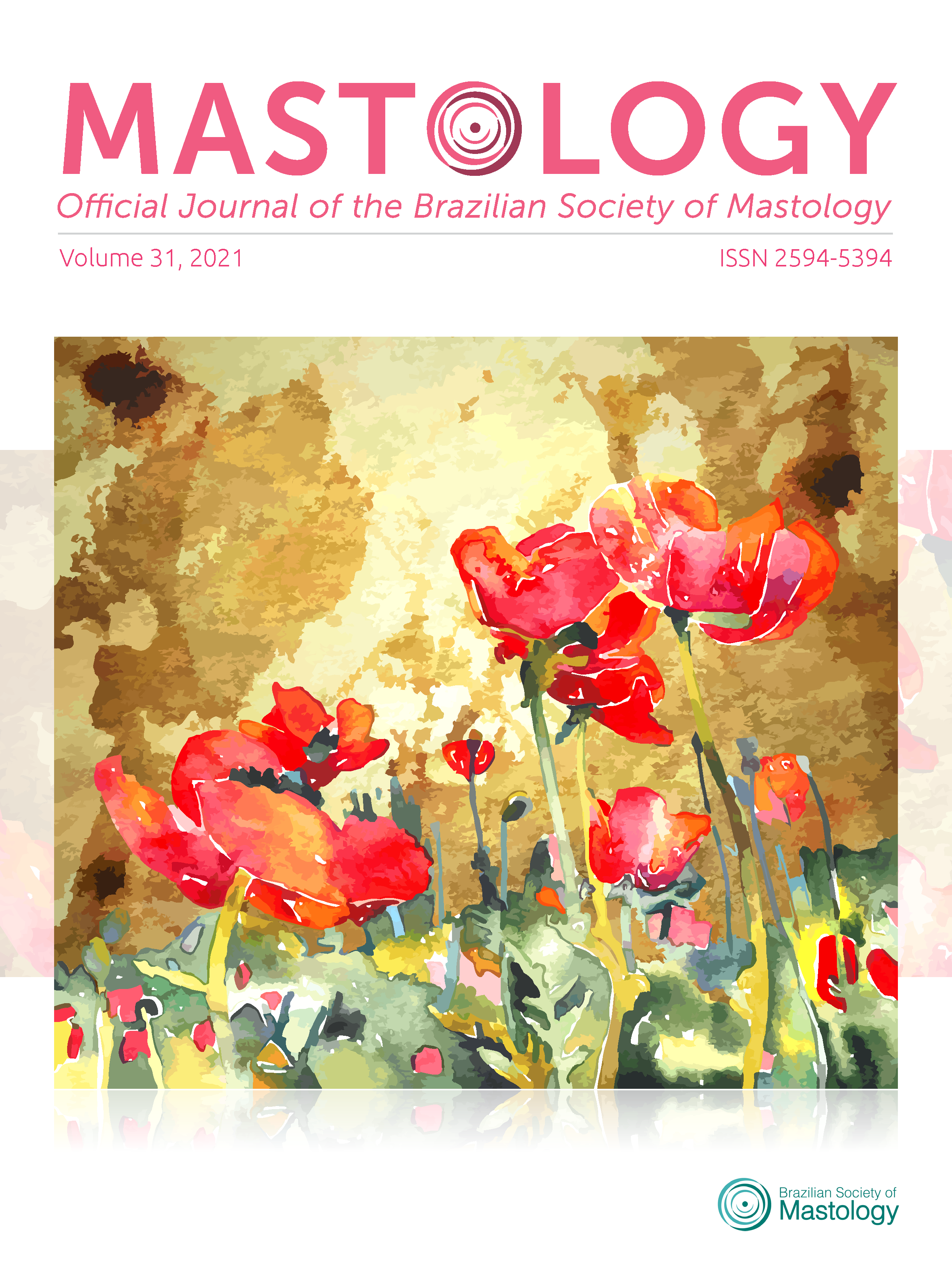Analysis of bilateral breast carcinomas
a profile of patients at a reference service
Keywords:
Breast neoplasms, Synchronous neoplasm, Metachronous neoplasmAbstract
Objective: To select cases of bilateral breast carcinoma (BBC) of patients seen at Hospital de Clínicas of Paraná, besides recognizing clinical and family characteristics, histological and immunohistochemical pattern, and incidences of synchronic/metachronic tumor in these patients. Method: Observational and analytical study of BBC cases of patients treated at Hospital de Clínicas of Paraná, from 2003 to 2019, developed from the analysis of medical records. Result: A total of 42 patients with BBC were selected. The incidence of BBC was 3.64%. All patients were women, mostly of white skin color and postmenopausal, with an average age of 51.82 years. Half patients showed a positive family history for cancer, with breast cancer present in 46%, ovarian cancer in 16%, and other topographies in 68%. In this sample, the synchronous tumor was present in 55% of patients, and the metachronous tumor, in 45%. Regarding patients’ initial clinical staging, 61% had a locally advanced tumor at diagnosis. Both in the group of synchronic and metachronic tumors, the ductal subtype was the most frequent. Regarding the immunohistochemical subtype, patients in both groups had Luminal B tumors more frequently. In the group of metachronic tumors, the average time between the diagnosis of the first tumor and the second tumor was 5.68 years. Conclusion: In this sample, BBC is associated with a relevant family history, with a synchronic presentation pattern, from histology to ductal and immunohistochemistry to Luminal B as the most frequent.
Downloads
References
Manea E, Munteanu A. Evolution of synchronous bilateral breast carcinoma in a young patient. Rev Med Chir Soc Med Nat Iasi. 2016;120(1):192-6. PMID: 27125095
Vuoto HD, García AM, Candás GB, Zimmermann AG, Uriburu JL, Isetta JA, et al. Bilateral breast carcinoma: clinical characteristics and its impact on survival. Breast J. 2010;16(6):625-32. https://doi.org/10.1111/j.1524-4741.2010.00976.x
Gollamudi SV, Gelman RS, Peiro G, Schneider LJ, Schnitt SJ, Recht A, et al. Breast-conserving therapy for stage I-II synchronous bilateral breast carcinoma. Cancer. 1997;79(7):1362-9. https://doi.org/10.1002/(SICI)1097-0142(19970401)79:7<1362::AID-CNCR14>3.0.CO;2-Y
Imyanitov EN, Hanson KP. Molecular pathogenesis of bilateral breast cancer. Cancer Lett. 2003;191(1):1-7. https://doi.org/10.1016/s0304-3835(02)00523-2
Kilgore AR, Bell HG, Ahlquist Junior RE. Cancer in the second breast. Am J Surg. 1956;92(2):156-61. https://doi.org/10.1016/s0002-9610(56)80055-x
Mau C, Untch M. Prophylactic surgery: for whom, when and how? Breast Care (Basel). 2017;12(6):379-84. https://doi.org/10.1159/000485830
Hunt KK, Euhus DM, Boughey JC, Chagpar AB, Feldman SM, Hansen NM, et al. Society of surgical oncology breast disease working group statement on prophylactic (risk-reducing) mastectomy. Ann Surg Oncol. 2017;24(2):375-97. https://doi.org/10.1245/s10434-016-5688-z
Beckmann KR, Buckingham J, Craft P, Dahlstrom JE, Zhang Y, Roder D, et al. Clinical characteristics and outcomes of bilateral breast cancer in an Australian cohort. Breast. 2011;20(2):158-64. https://doi.org/10.1016/j.breast.2010.10.004
Chen Y, Thompson W, Semenciw R, Mao Y. Epidemiology of contralateral breast cancer. Cancer Epidemiol Biomarkers Prev. 1999;8(10):855-61. PMID: 10548312
Daly MB, Pilarski R, Berry M, Buys SS, Farmer M, Friedman S, et al. NCCN guidelines insights: genetic/familial high- risk assessment: breast and ovarian, version 2.2017. J Natl Compr Canc Netw. 2017;15(1):9-20. https://doi.org/10.6004/jnccn.2017.0003
Hemminki K, Ji J, Försti A. Risks for familial and contralateral breast cancer interact multiplicatively and cause a high risk. Cancer Res. 2007;67(3):868-70. https://doi.org/10.1158/0008- 5472.CAN-06-3854
Reiner AS, John EM, Brooks JD, Lynch CF, Bernstein L, Mellemkjær L, et al. Risk of asynchronous contralateral breast cancer in noncarriers of BRCA1 and BRCA2 mutations with a family history of breast cancer: a report from the Women’s Environmental Cancer and Radiation Epidemiology Study. J Clin Oncol. 2013;31(4):433-9. https://doi.org/10.1200/JCO.2012.43.2013
Malone KE, Begg CB, Haile RW, Borg A, Concannon P, Tellhed L, et al. Population-based study of the risk of second primary contralateral breast cancer associated with carrying a mutation in BRCA1 or BRCA2. J Clin Oncol. 2010;28(14):2404- 10. https://doi.org/10.1200/JCO.2009.24.2495
Metcalfe K, Gershman S, Lynch HT, Ghadirian P, Tung N, Kim- Sing C, et al. Predictors of contralateral breast cancer in BRCA1 and BRCA2 mutation carriers. Br J Cancer. 2011;104(9):1384- 92. https://doi.org/10.1038/bjc.2011.120
Adami HO, Bergström R, Hansen J. Age at first primary as a determinant of the incidence of bilateral breast cancer. Cumulative and relative risks in a population- based case-control study. Cancer. 1985;55(3):643-7. https://doi.org/10.1002/1097-0142(19850201)55:3<643::aid-cncr2820550328>3.0.co;2-l
Jobsen JJ, van der Palen J, Ong F, Riemersma S, Struikmans
H. Bilateral breast cancer, synchronous and metachronous; differences and outcome. Breast Cancer Res Treat. 2015;153(2):277-83. https://doi.org/10.1007/s10549-015-3538-5
Kurian AW, McClure LA, John EM, Horn-Ross PL, Ford JM, Clarke CA. Second primary breast cancer occurrence according to hormone receptor status. J Natl Cancer Inst. 2009;101(15):1058-65. https://doi.org/10.1093/jnci/djp181
Kappikeri VK, Kriplani AM. Bilateral synchronous carcinoma breast- a rare case presentation. Springerplus. 2015;4:193. https://doi.org/10.1186/s40064-015-0953-3
Mai PL, Best AF, Peters JA, DeCastro RM, Khincha PP, Loud JT, et al. Risks of first and subsequent cancers among TP53 mutation carriers in the National Cancer Institute Li- Fraumeni syndrome cohort. Cancer. 2016;122(23):3673-81. https://doi.org/10.1002/cncr.30248
Carbine NE, Lostumbo L, Wallace J, Ko H. Risk-reducing mastectomy for the prevention of primary breast cancer (Review). Cochrane Database Syst Rev. 2018;4(4):CD002748. https://doi.org/10.1002/14651858.CD002748.pub4
Hartmann LC, Schaid DJ, Woods JE, Crotty TP, Myers JL, Arnold PG, et al. Efficacy of bilateral prophylactic mastectomy in women with a family history of breast cancer. N Engl J Med. 1999;340(2):77-84. https://doi.org/10.1056/NEJM199901143400201
Heemskerk-Gerritsen BA, Rookus MA, Aalfs CM, Ausems MG, Collée JM, Jansen L, et al. Improved overall survival after contralateral risk-reducing mastectomy in BRCA1/2 mutation carriers with a history of unilateral breast cancer: a prospective analysis. Int J Cancer. 2015;136(3):668-77. https://doi.org/10.1002/ijc.29032
Rebbeck TR, Friebel T, Lynch HT, Neuhausen SL, van ‘t Veer L, Garber JE, et al. Bilateral prophylactic mastectomy reduces breast cancer risk in BRCA1 and BRCA2 mutation carriers: the PROSE Study Group. J Clin Oncol. 2004;22(6):1055-62. https://doi.org/10.1200/JCO.2004.04.188
Downloads
Published
How to Cite
Issue
Section
License
Copyright (c) 2021 Camila Vitola Pasetto, Bruno Ribeiro Batista, Lucas Roskamp Budel, Mariana De Nadai Andreoli, Vinicius Milani Budel

This work is licensed under a Creative Commons Attribution 4.0 International License.







